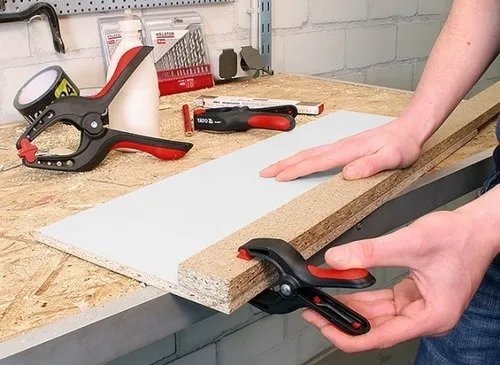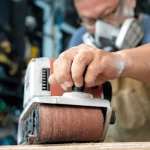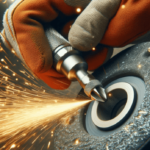What are Spring Clamps?
Spring clamps, also known as spring clips or spring-loaded clamps, are versatile tools used for temporarily holding objects together or securing materials in place. They consist of two jaws or clamping surfaces connected by a spring mechanism that exerts a clamping force.
The basic design of a spring clamp features two clamping jaws, typically made of metal or plastic, connected by a coiled spring or torsion spring. The spring provides the necessary tension to keep the jaws closed and secure the clamped object. When the jaws are opened, the spring compresses, and when released, the spring’s force clamps the jaws shut, creating a tight grip.
Spring clamps are commonly used in various applications, such as woodworking, metalworking, construction, and household projects. They are particularly useful for holding workpieces in place during assembly, gluing, painting, or other processes. Spring clamps can also be used to temporarily secure materials like pipes, cables, or hoses during installation or repair.
The clamping mechanism of spring clamps allows for quick and easy one-handed operation. The user can open the jaws with one hand, position the clamp around the desired object, and release the jaws to secure it in place. This versatility and ease of use make spring clamps a popular choice for a wide range of tasks.
Table of Contents
Types of Spring Clamps
Spring clamps come in various types, each designed for specific applications and purposes. The main types include:
- Locking Spring Clamps: These clamps feature a locking mechanism that secures the jaws in place, preventing accidental release or slippage. They are ideal for situations where a constant clamping force is required over an extended period.
- Non-Locking Spring Clamps: As the name suggests, these clamps do not have a locking mechanism. They rely solely on the spring tension to maintain the clamping force. Non-locking clamps are typically used for temporary or quick clamping tasks.
- Panel Clamps: Panel clamps are designed specifically for clamping and securing panels, such as wood, plastic, or metal sheets. They often have flat, wide jaws to distribute the clamping force evenly across the surface.
- C-Clamps: C-clamps feature a C-shaped frame with a fixed jaw on one end and a movable jaw on the other. They are versatile and can be used for a variety of clamping applications, including woodworking, metalworking, and general repairs.
- F-Clamps: F-clamps, or bar clamps, consist of a long bar with adjustable jaws at each end. They are commonly used in woodworking projects to clamp and hold workpieces together while glue or other adhesives cure.
- Bar Clamps: Similar to F-clamps, bar clamps have a long bar with adjustable jaws, but they often feature a different clamping mechanism and may have additional features like swiveling jaws or quick-release levers.
Each type of spring clamp has its unique advantages and is suitable for specific tasks. Choosing the right clamp depends on factors such as the material being clamped, the required clamping force, and the size and shape of the workpiece.
Materials and Construction
Spring clamps are typically constructed from high-quality metals to ensure durability and strength. The most common materials used are:
Metals:
- Steel: Carbon steel and stainless steel are widely used for their excellent tensile strength and resistance to wear and corrosion.
- Aluminum: Lightweight yet strong, aluminum is often used for smaller or lighter-duty clamps.
Coatings:
- Zinc Plating: Provides corrosion resistance and a bright finish.
- Chrome Plating: Offers a sleek appearance and enhances corrosion resistance.
- Powder Coating: Provides a durable, colored finish that resists chipping and scratching.
Jaw Materials:
- Steel: Hardened steel jaws offer superior gripping power and longevity.
- Plastic/Rubber: Soft jaw pads prevent marring or damaging delicate surfaces.
Spring Design:
- Coiled Springs: Made from tempered steel wire, coiled springs provide consistent clamping force.
- Leaf Springs: Flat, curved springs offer greater strength and durability for heavy-duty applications.
- Torsion Springs: Twisted wire springs deliver a high clamping force in a compact design.
The combination of high-quality materials, protective coatings, and carefully engineered spring designs ensures that spring clamps can withstand demanding applications while providing reliable clamping performance.
Working Principles
Spring clamps utilize the mechanical properties of a coiled spring to apply clamping force. The spring is compressed between two jaws or pads, creating tension that holds materials securely in place. As the spring compresses, it stores potential energy, which translates into clamping force once the jaws are tightened around an object.
The key advantage of spring clamps lies in their ability to maintain consistent clamping pressure, even as the materials being clamped expand or contract due to temperature changes or other factors. This self-adjusting feature ensures a firm grip without the need for constant retightening, making spring clamps ideal for applications where clamping forces may need to be maintained over extended periods.
Another benefit of spring clamps is their versatility in accommodating a wide range of material thicknesses and shapes. By adjusting the jaw opening and selecting the appropriate spring tension, these clamps can securely hold everything from thin sheets to thick workpieces. Their simple yet effective design allows for quick and easy clamping and unclamping, saving time and effort compared to more complex clamping solutions.
Furthermore, spring clamps offer a distinct advantage over conventional clamps in terms of safety. Since the clamping force is generated by the spring mechanism, there is no risk of overtightening or excessive force being applied, reducing the potential for material damage or personal injury.
Sizing and Capacities
Spring clamps are available in a wide range of sizes to accommodate different clamping needs. The size of a spring clamp is typically determined by its clamping force rating and throat depth.
Available Sizes: Spring clamps can be found in sizes ranging from miniature clamps suitable for delicate work to heavy-duty clamps capable of exerting tremendous clamping force. Common size designations include mini, small, medium, large, and extra-large.
Clamping Force Ratings: The clamping force rating indicates the maximum force the clamp can apply. This rating is usually expressed in pounds or newtons. Spring clamps can have clamping force ratings ranging from just a few pounds for light-duty applications to several hundred pounds for heavy-duty tasks.
Throat Depths: The throat depth refers to the maximum opening distance between the jaws of the clamp. Spring clamps are available with various throat depths to accommodate different workpiece thicknesses or clearance requirements. Throat depths can range from a fraction of an inch for small clamps to several inches for larger clamps.
When selecting a spring clamp, it’s essential to consider the specific application and the required clamping force and throat depth. Choosing the appropriate size and capacity ensures that the clamp can securely hold the workpiece without slipping or causing damage.
Applications and Uses
Spring clamps are versatile tools with a wide range of applications in various fields, including woodworking, metalworking, crafts, DIY projects, and more. Their ability to securely hold workpieces in place makes them invaluable in many industries and hobbies.
Woodworking
Spring clamps are essential tools in woodworking shops and for carpentry projects. They are commonly used for gluing and clamping wood pieces together during assembly, ensuring a tight and secure bond. Spring clamps can hold boards, panels, frames, and other wooden components in place while the adhesive dries or until further processing is complete.
Metalworking
In metalworking, spring clamps are used to hold metal pieces securely during welding, cutting, grinding, or other fabrication processes. They provide a firm grip on the workpieces, preventing them from shifting or moving during operations, ensuring precision and safety.
Crafts and DIY Projects
Spring clamps are handy tools for various craft projects and DIY enthusiasts. They can be used to hold materials like fabric, leather, paper, or cardboard in place while gluing, painting, or assembling. Spring clamps are also useful for securing items during drying or curing processes, such as when working with resin, clay, or other moldable materials.
Holding Workpieces
One of the primary uses of spring clamps is to hold workpieces securely in place during various operations. They can be used to clamp materials to workbenches, tables, or other surfaces, providing a stable and secure working environment. Spring clamps are also useful for holding objects together temporarily while drilling, sawing, or performing other tasks that require precise alignment and stability.
With their versatility and ability to apply consistent clamping force, spring clamps are invaluable tools for professionals, hobbyists, and DIY enthusiasts alike, ensuring safety, precision, and efficiency in a wide range of applications.
Safety Precautions
Spring clamps are essential tools in various industries, but they can pose safety risks if not used properly. Proper clamping technique is crucial to ensure safe operation and prevent accidents. Always follow the manufacturer’s instructions and never exceed the clamp’s rated capacity.
Before using a spring clamp, inspect it thoroughly for any defects, such as cracks, wear, or deformation. Damaged clamps should be immediately removed from service and replaced to avoid potential failure and injury. Additionally, keep the clamp’s jaws and surfaces clean and free from debris, as foreign objects can interfere with the clamping action and cause slippage.
Pinch hazards are a significant concern when working with spring clamps. When applying or releasing the clamp, keep your fingers and hands away from the clamping area to prevent pinching or crushing injuries. Wear appropriate personal protective equipment (PPE), such as gloves, to minimize the risk of injuries.
When clamping workpieces, ensure that they are properly secured and supported to prevent unexpected movement or shifting. Never stand directly in front of the clamping area, as a sudden release of tension could cause the workpiece or clamp to fly off, posing a risk of serious injury.
Care and Maintenance
Proper care and maintenance of spring clamps are essential for ensuring their longevity, safety, and optimal performance. Here are some guidelines for maintaining your spring clamps:
Cleaning
Regular cleaning is crucial to prevent the accumulation of dirt, debris, and corrosion, which can compromise the clamp’s functionality and strength. Use a soft-bristle brush or a clean cloth to remove any dirt or grime from the clamp’s surface. Avoid using harsh chemicals or abrasive materials, as they may damage the clamp’s finish or components.
Lubrication
Lubrication is essential for maintaining the smooth operation of spring clamps, particularly those with moving parts. Use a high-quality, rust-preventive lubricant specifically designed for tools and equipment. Apply a thin layer of lubricant to the pivot points, threads, and other moving components, ensuring even distribution. Wipe off any excess lubricant to prevent attracting dirt and debris.
Storage
Proper storage is crucial for protecting spring clamps from environmental factors that can cause corrosion or damage. Store clamps in a clean, dry, and well-ventilated area, away from moisture, extreme temperatures, and direct sunlight. If possible, use a protective case or storage cabinet to keep the clamps organized and prevent accidental damage.
Inspecting for Wear
Regularly inspect your spring clamps for signs of wear, such as cracks, deformations, or excessive rust. Pay close attention to the spring mechanism, as worn or damaged springs can compromise the clamp’s holding power and safety. If you notice any significant wear or damage, replace the clamp immediately to prevent potential accidents or failures.
By following these care and maintenance guidelines, you can extend the lifespan of your spring clamps, ensure their reliable performance, and maintain a safe working environment.
Choosing the Right Spring Clamp
Selecting the appropriate spring clamp for your application is crucial to ensure optimal performance, safety, and durability. Here are some key factors to consider when choosing the right spring clamp:
Size and Capacity: Spring clamps come in various sizes and clamping force capacities. Determine the maximum opening required and the necessary clamping force based on the materials and thickness of the workpieces you’ll be clamping. It’s essential to choose a clamp that can accommodate your workpiece dimensions and provide sufficient clamping force without damaging the material.
Intended Use: Consider the specific application or task you’ll be using the spring clamp for. Different clamps are designed for various purposes, such as woodworking, metalworking, welding, or general-purpose clamping. Choose a clamp that is suitable for your intended use and can withstand the conditions it will be exposed to, such as heat, chemicals, or vibrations.
Material and Finish: Spring clamps are available in different materials, including steel, aluminum, and plastic. Each material has its advantages and disadvantages in terms of strength, durability, and corrosion resistance. Additionally, some clamps may have protective coatings or finishes to enhance their performance or appearance. Consider the environment and conditions in which the clamp will be used to select the appropriate material and finish.
Ergonomics and Ease of Use: Look for spring clamps that are comfortable to use and offer easy operation. Factors like handle design, grip surfaces, and release mechanisms can impact user comfort and efficiency, especially when working on projects that require frequent clamping and unclamping.
Brand and Quality: Research and choose reputable brands known for manufacturing high-quality spring clamps. Reliable brands typically offer better quality control, consistent performance, and longer service life. Additionally, consider customer reviews and ratings to gauge the overall satisfaction and reliability of specific clamp models.
By carefully evaluating these factors, you can select the most suitable spring clamp for your needs, ensuring optimal performance, safety, and efficiency in your projects.
Top Brands and Products
Spring clamps are widely available from various manufacturers, each offering different product lines and models tailored to specific applications and industries. Here’s an overview of some of the leading brands and popular spring clamp products:
Bessey Tools: Bessey is a renowned German manufacturer of clamping tools, including a comprehensive range of spring clamps. Their EZS series of spring clamps, available in different sizes and clamping forces, are popular among woodworkers and DIY enthusiasts. The Bessey Tradesman series is designed for heavy-duty applications in construction and industrial settings.
IRWIN Tools: IRWIN offers a variety of spring clamps under their QUICK-GRIP line. These clamps are known for their durability and ease of use, with ergonomic handles and quick-release mechanisms. The QUICK-GRIP XP series features extended reach and larger clamping capacities, making them suitable for various projects.
Jorgensen: Jorgensen is a trusted name in the woodworking industry, known for their high-quality clamps and accessories. Their spring clamp lineup includes the 7000 series for general-purpose clamping and the 3700 series for heavy-duty applications. Jorgensen also offers specialized spring clamps for cabinet installation and gluing operations.
Pony Tools: Pony Tools is a popular brand among DIYers and professionals alike, offering a range of spring clamps at different price points. Their Pony Pipe Clamp series is designed for plumbing and pipe-fitting applications, while the Pony Adjustable Spring Clamp series caters to various woodworking and general clamping needs.
Rockler: Rockler is a leading supplier of woodworking tools and accessories, including a selection of spring clamps. Their Rockler Bench Clamp series is designed for clamping workpieces to workbenches or tables, while their Corner Clamps are ideal for gluing and assembling cabinet frames and boxes.
These are just a few examples of the many brands and product lines available in the market. When choosing spring clamps, it’s essential to consider factors such as clamping force, jaw opening, reach, and intended application to ensure you select the right tool for the job.



